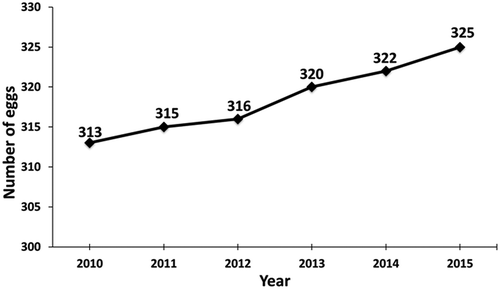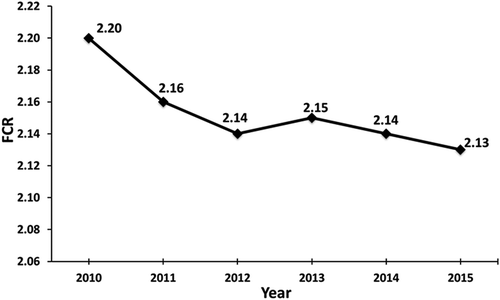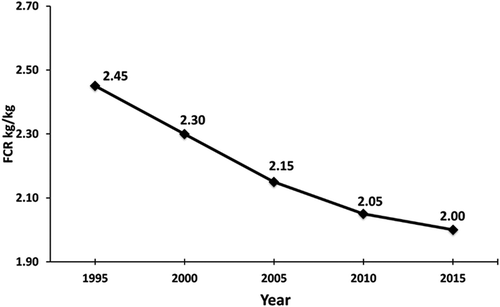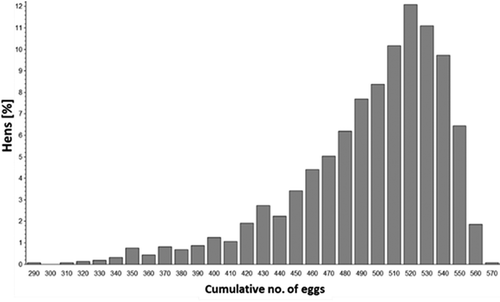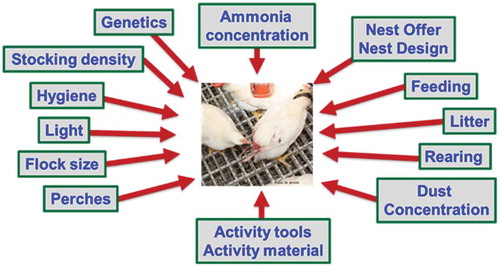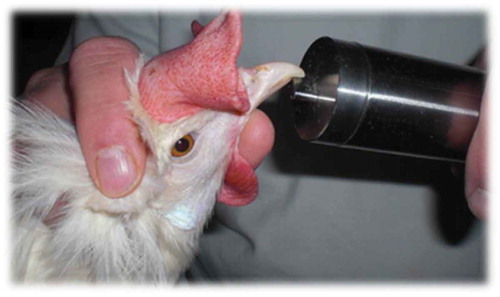ABSTRACT
1. In commercial layer breeding, extensive gene pools are tested and selected for market requirements which must be anticipated at least 5 years ahead. Field results confirm a continuous positive genetic trend in egg output and better feed efficiency which can be converted into land savings.
2. Animal welfare and cage-free housing dominate future needs of the market. Nesting behaviour and minimal tendency to develop feather-pecking or cannibalism without beak treatment are key trait complexes. Stronger shells for longer production cycles without moulting have to be combined with better bones.
3. No single big gene effect can be expected to control the multifactorial problem of feather-pecking. Adjusting the shape of the beak, with a heritability of .10–.25, can contribute to reducing the risk of severe cannibalism.
4. For better skeletal integrity, the assessment of bone quality in pedigree birds housed in enriched cages is done by keel bone palpation or ultrasound measurement of the humerus. Both traits show similar heritabilities in the range of .15–.30 and can be included in a balanced selection approach for performance, quality and welfare traits.
5. The combination of performance testing and genome-wide DNA marker analysis is a promising tool to generate more progress for a balanced performance and behaviour profile.
Introduction
Today’s population of more than 7 billion will grow steadily and by 2050, this will reach about 9 billion. In order to feed the growing human population, the production of food will have to be more efficient in terms of utilizing the limited resources that we have. We have to produce large amounts of high quality protein with affordable prices to cover the growing demand. Production systems need to be environmentally friendly, socially responsible and economically viable. Selective breeding of farm animals can make a major contribution to this global challenge.The demand for eggs is at a level of 75 million tonnes with an annual increase of 1 million tonnes each year. To satisfy the increasing demands, at least 50 million hens will have to be added each year, assuming management conditions to support the genetic potential for 20 kg egg mass per hen, i.e. from 20 to 76 weeks of age. Current per capita egg consumption and the rate of change differ considerably between continents and countries within continents, depending on traditions, purchasing power and the ability of other sources of food. Europe and North America have little growth potential, while the demand in countries like China, India, Latin America and certain countries in Africa is expected to grow considerably, especially due to changing consumer habits of educated urban people with the necessary purchasing power.
Consumer habits and preferences for specific egg characteristics like shell colour and egg size also differ between countries and between consumers within a country. Japan, for example, has maintained one of the highest levels of consumption with more than 300 eggs per capita for decades. The custom of breaking a raw egg over a bowl of rice for breakfast helps to explain the focus on egg quality: white-shelled eggs with superior internal egg quality and guaranteed freedom from Salmonella. White eggs are also preferred in North and Central America, the Middle East, India, Taiwan and the Philippines, whereas brown eggs are preferred in most of Latin America, Europe and China. Tinted eggs, produced from crosses between White Leghorns and brown-egg breeds, are popular in Japan and China, but seldom seen in Europe.
The layer breeding industry has gone through significant changes during the past decades and has a remarkable record of coping with new challenges. Increased egg production, improved feed efficiency and adaptation of egg quality to consumer preferences have contributed significantly to the success of the poultry industry. Without these genetic improvements and corresponding improvement of nutrition, disease control and general farm management, the poultry industry would not have achieved its current position in the global food market. While the focus has to remain on maximizing the genetic potential for producing high quality protein at competitive cost, additional requirements of the egg industry, changing consumer habits and public opinion have to be taken into account.
General layout of layer breeding
Primary breeders have to look beyond current requirements and anticipate changing needs and opportunities at least 5 years into the future. Close communication between breeders and distributors is necessary to introduce new varieties at the right time to benefit from growing niche markets. For the global layer business, diverse markets have to be served and each of these may prefer different performance profiles of the commercial layers. This requires extensive gene pools with large elite lines which can be combined to generate strain crosses with specific attributes to meet market needs as closely as possible. Maintaining and developing new lines, testing, selection and reproduction of primary stocks involve high fixed costs in the operation and require superior skills in quantitative genetics as well as internal organization to keep track of the availability of different sub-lines for niche markets. Genetic development, marketing and technical support have to communicate closely with local distributors to provide the best possible service for the current market and to benefit from changing requirements. Major challenges for the layer industries are constantly high feed prices and animal welfare that is gaining more importance not only in Europe but also in North America.
Geneticists must anticipate at least 5 years ahead as to what the market trends will be like as well as consumer orientation. When alternative husbandry and organic egg production were introduced some years ago, no one believed that these would someday become dominant market trends. At the time when the prospect of a prohibition of beak treatment was outlined, no one would have ever imagined that it would actually happen in several European countries. The same goes for male chicks, whose culling will be prohibited and replaced by determining sex in the egg. In fact, European legislation forbidding any kind of amputation to animals has been in place for a long time now. In the next 5 years, for example, the determination of sex in the egg will be a reality, or even the demand for layer nutrition where only non-genetically modified (GM) raw materials and ingredients are to be used in the formulation.
Future selection goals are geared towards extending the production period and increasing the number of saleable eggs per hen, improving shell quality and hen liveability with consistent feather cover until the end of lay. Stronger shells for longer cycles without moulting have to be combined with better bones. Bone strength and breakage can be a major issue in cage-free environments. Also, environmental enrichment with perches can be a challenge for the skeletal integrity and bone lesions.
Housing systems vary between continents and within Europe. In Switzerland, Austria, Sweden and Germany, commercial layer cages have been banned for several years. Enriched cages, considered by poultry scientists as an acceptable compromise between the demands of animal welfare organizations and the ‘needs’ of laying hens, are installed in Europe as an alternative to conventional battery cages. Retailers and animal welfare groups in different countries continue to lobby for a complete ban on cages in Europe. Even in North America, a change from cage systems to aviary systems is most likely within the next decade.
To supply the best possible combination for each market with specified optimal egg weight and most common housing system, every breeding company has to offer different strain crosses, which are all selected with focus on efficient egg production, but with different emphasis on individual selection traits. For line improvement, pure-line and cross-line hens are tested in different environments: in single, small group and family cages as well as under floor conditions with a new kind of ‘trap-nesting’. The majority of single bird cages are enriched with perches, nests and scratching areas with the aim of creating a testing system which is as close as possible to future housing systems with more floor space and several enrichments. Daily egg production is recorded with the aid of barcode readers; various egg quality traits (mainly egg weight, shell strength, shell colour and internal egg quality) and plumage condition are recorded on a sample basis across the production cycle. Individual feed intake and daily egg mass are determined at peak production, i.e. during the time of maximum performance, so that selection for improved efficiency reflects the capacity for sufficient feed intake at a time of greatest nutrient demand.
Testing under floor conditions with trap-nesting to measure individual egg production and egg quality was practiced in the breeding program of Lohmann Tierzucht until about 1970, but was replaced by more efficient single cage and group cage testing. Almost 10 years ago, testing individual performance in floor systems was resumed, using a specially adapted transponder technique and the Weihenstephan Funnel Nest Box (Icken et al. Citation2012) to obtain individual information on egg production, nest acceptance and utilization of outdoor facilities (winter garden or free-range). The data are used in family selection for ‘number of saleable nest eggs’, penalizing families with poor nest acceptance which tend to produce floor eggs. The moderate heritability of ‘nest eggs’ recorded in these floor systems suggests that further progress can be made. However, egg producers should not expect miracles from genetic selection and must pay proper attention to rearing conditions, a timely transfer to the production house and optimal nest arrangement to minimize the number of displaced eggs. Critical are also an adequate lighting regime adjusted feed formulation and feeding.
For the foreseeable future, we can safely assume that general breeding goals such as egg number, feed efficiency and egg quality traits will remain priorities. Behaviour patterns and especially behaviour anomalies are likely to get more attention outside the Western world. Suitability for floor housing and free-range systems has become more important, and this includes attention to a whole range of traits: acceptance of nests and free-range, persistent plumage cover to the end of lay, resistance to common diseases and minimal tendency to develop feather-pecking or cannibalism. National laws and regulations will reflect continuing attempts to define priorities and ‘sustainability’ in terms of adequate nutrition for the growing human population, protection of the environment and natural resources, ethical standards for animal farming, and – last but not least – economics.
Genetic trends
Continuous improvement in egg production per hen housed is the most important selection criterion in layer breeding. Field results have confirmed the genetic trend. An annual increase of about two to three eggs per year in a 13-month production cycle can be expected ().
At the same time, feed efficiency has improved considerably. When breeding companies established a system for individual feed recording, body weight of brown layers and daily feed intake were reduced. Today, an optimum body weight for white and brown layers is achieved. After 2012, the improvement in feed efficiency, as shown in , is mainly driven by a stable maintenance requirement and constant daily feed intake. Improved egg mass output is the major driver for a further improvement in feed efficiency.
From a global perspective on the sustainability and efficiency of egg production in the last 20 years, we can deduce that there has been an improvement of about 0.45 kg less feed per kg egg mass produced (). When the savings in feed are converted into resource saving in different countries and regions, we can estimate a saving of 57 000 tonnes of feed which is equivalent to 8 million hectares of land over the last 20 years of egg production for the global commercial layer population ().
Table 1. Savings of feed and land in different parts of the world from better feed efficiency in the last 20 years.
Changing expectations of consumers in terms of animal-friendly housing systems have put pressure on retailers. The United States alone, according to the United Egg Producers, has to convert up to 190 million hens from cage to cage-free production. A change in housing system will cause an increase in production costs of 14–28% due to higher space requirements, higher feed intake, increased mortality and more downgraded eggs. However, with new housing systems and a small flock size, an even better egg output per hen can be achieved compared with old, large and multiple age complexes. Flock records in can be used as a typical example for the genetic potential realized in cage-free environments. Persistency in lay is one of the major drivers for further improvements in egg production in all housing systems.
Figure 4. Comparison in egg production between stand-alone cage-free houses and multiple age cage-housing (LSL-Lite in USA).
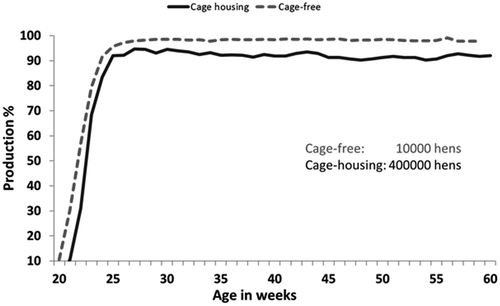
Genetic potential
In order to get a better and more detailed overview about the performance of each individual hen within a flock, a special recording system was established. A total of 1613 hens with similar genetic background were tested individually over a period of 82 production weeks (21–102 weeks of age). In the 574 production days, 56% of all the hens reached the target of 500 saleable eggs with a range of 515–574 d to produce them. The maximum clutch size was up to 400 d without any breaks in between. Despite a very long clutch length of the majority of the birds, there was still a significant number of hens producing less than 400 eggs while others produced 100 or 150 eggs more at the same time ().
If we look into more details of daily egg production, as demonstrated in , we can see a typical pattern of clutches interrupted by a break of 1 or 2 d without an egg. Clutch length does not follow a very strict pattern. In the second half of the production cycles, clutches were shorter without an extended increase in the length of the pause.
Table 2. Egg numbers presented in laying sequences (clutch size) for a recording period of 515 days in a hen laying at a rate of egg production of 97%
Animal behaviour
Over decades, in all parts of the world, beak trimming has been used to prevent feather-pecking in poultry. Feather-pecking is caused by a number of factors and no single big gene effect can be expected to control this multifactorial problem (). Increasing ethical reservations have caused a ban on beak-trimming, including the infrared treatment, even on day-old chicks in the hatchery. Since 1 July 2016, a ban on beak treatment was introduced for 80 million hens under the auditing system of KAT (‘Kontrollierte Alternative Haltung’ – Controlled Alternative Husbandry) in Germany. Branded eggs from Germany, The Netherlands, Austria, Italy and France with the quality label of KAT represent about 80 million hens in Europe. There is a high probability that other countries and/or marketing organizations will follow this trend.
An indirect approach to reduce the risk of feather-pecking and cannibalism can be done by means of manipulating the shape of the beak by genetic selection. However, before a new trait can be introduced to a commercial breeding programme, the trait has to be measured with high accuracy and the heritability has to be estimated. Repeated measurements on the same individuals can increase the reliability and power of selection. Progeny testing is also an option to increase the number of records and the power of selection; however, progeny testing is very costly and time consuming.
A special device was developed to measure beak shape in terms of the extension of the upper beak beyond the lower beak in pedigreed hens and to evaluate the usefulness of this criterion as an additional selection criterion to reduce feather-pecking. The working hypothesis was that birds with blunt beaks should be less inclined or less successful in pulling feathers from group mates or starting cannibalistic behaviour.
The heritability estimates for beak shape at 45 weeks of age range from 0.13 to 0.25 and from 0.09 to 0.26 for 4 lines each of the Lohmann Brown and LSL breeding programs, respectively. These genetic parameters and the high variability of the trait suggest that a reduction of beak length through genetic selection should be feasible. The heritabilities are at a similar level as for traits like plumage condition or persistency of egg production (Icken et al. Citation2017) ().
Table 3. Heritability for beak length in LSL and Lohmann Brown pure lines.
As shown in , the special device to measure the upper beak length gives a good indicator for the shape of the beak and the length of the hook.
Bone quality
With an increased production cycle length, skeletal integrity and bone fracture in layers are gaining more importance. Bone strength and shell strength are competing characteristics with housing system and animal nutrition affecting these traits in addition to genetics (Bishop et al. Citation2000; Fleming et al. Citation2006). Measuring bone characteristics retrospectively after the breeding hens are slaughtered at the end of the laying period cannot be implemented efficiently in a commercial breeding programme. This means that excessive numbers of progeny have to be produced and selected on the bone characteristics of their dams.
A viable alternative for genetic selection should be based on the assessment of bone quality of the selection candidate itself. The method must be fast and accurate to screen all selection candidates for quality. Two different options have been used to score the bone quality in adult leghorn pedigree hens. Birds were housed in enriched single bird cages with a perch, nest box and a scratching area. A subjective human scoring of keel bone deformation was performed on a scale from 1 to 3 (Anderson et al. Citation2017) for almost 6000 hens. Keel bone palpation was done at 46 and 70 weeks of age. Ultrasound measurement of the humerus was taken at 64 weeks of age. Both traits show reasonable heritabilities with a small advantage for the male line. Keel bone assessment can be done much faster compared with ultrasound examination, showing similar heritabilities (). Future studies have to show which traits reflect the risk of bone breakage better. It can already be concluded, at this stage, that phenotypic recording of bone quality in live birds can contribute to better bone quality when it is included in the selection index. Both traits are available during selection and will be part of the balanced selection approach in commercial layers. An additional and major step forward, in bone quality, can be achieved if genetic markers for osteoporosis would be available for selection (Dunn et al. Citation2007).
Table 4. Heritability for keel bone examination and ultrasound examination of the humerus in LSL pure lines.
Conclusion
Primary breeders will continue to invest in additional testing capacities which reflect typical field conditions in different markets. At the same time, the genetic basis of the elite lines will be expanded to accommodate the demand of growing markets, which in turn will minimize the rate of inbreeding and the risk of losing valuable genetic variation. A special programme to match selected males and females at the pedigree level assures that inbreeding effects are minimized and genetic progress continues at a predictable rate.
Advances in molecular biology have contributed to new techniques for selection. Using informative genetic markers, geneticists can identify individuals and families with special characteristics early in life and thereby accelerate improvements in egg production, egg quality, behaviour and liveability. These innovations complement traditional performance testing and evaluation methods based on phenotypic selection indexes of production, efficiency and quality parameters.
Combining all available performance records from relatives in several generations, locations and housing systems requires powerful computer programs, but assures that the best males and females are selected and mated to generate the next generation. Additional information based on DNA analysis is combined with traditional breeding values to select males at an earlier age and to differentiate among full brothers, which used to have identical breeding values from sib testing before DNA information became available. The combination of performance testing as described above and genome-wide analysis is a promising tool for developing new strain crosses with a performance profile tailored to specific requirements.
The current rate of genetic progress for total efficiency of egg production appears to be even greater than it was 20 years ago. An improved structure and increased size of breeding populations, the application of new testing and recording technologies and more powerful computer systems for breeding value estimation have contributed to more efficient use of existing genetic variation. The application of high throughput DNA screening using dense genome-wide Single-Nucleotide Polymorphism (SNP) markers is very valuable for selective breeding by so-called ‘genomic selection’. In genomic selection, the focus is not to estimate the effect of some specific genomic regions, but to use the combined effects of thousands of genome-wide SNP markers to estimate the breeding values of the pure-line chickens more reliably in both sexes. In the future, when costs for commercially available SNP chips would be further reduced, genomic selection will play an even greater role in improving the rate of genetic progress for layers used in conventional and non-cage environments. All selection candidates can be screened even in the rearing period before any phenotypic data are available.
Finally, we should realize that increased genetic potential needs to be ‘translated’ into reality in commercial practice. Disease control, farm management and nutrition have to keep pace with genetic improvements, and more efficient production is no guarantee for a sustainable farm income should the markets be oversupplied.
In the coming years, the prosperity of the egg industry will be driven by genetic progress and adjusted husbandry systems. Animal welfare will play a major role. Key indicators will be general liveability, good feather cover until the end of the production cycle and strong bones.
Breeders have to focus on a balanced breeding goal to cover the demand of the growing human population for high quality protein.
Accurate data recording in different environments, combined with genomic data, will make selection faster and more accurate, and enhance progress in persistency in rate of lay and late shell quality. The ultimate target will be increased cycle length in order to boost lifetime egg production per hen housed.
Disclosure statement
No potential conflict of interest was reported by the author.
References
- Andersson, B., W. Icken, D. Cavero, F. Kaufmann, and M. Schmutz 2017. “Different methodologies to genetically improve the robustness of bones in layers.” In Proceedings of the 10th European Symposium on Poultry Genetics, St. Malo, France, June 26-28, edited by C. Bostvironnoi, C. Lessire, M. Tixier-Boichard, 97 p. WPSA French Branch. http://wpsa.fr/congres/EuropeanPoutryGenetics/Index%20ESPG.html
- Bishop, S., R. Fleming, H. Mccormack, D. Flock, and C. Whitehead. 2000. “Inheritance of Bone Characteristics Affecting Osteoporosis in Laying Hens.” British Poultry Science 41: 33–40. doi:10.1080/00071660086376.
- Dunn, I., R. Fleming, H. Mccormack, D. Morrice, D. Burt, R. Preisinger, and C. Whitehead. 2007. “A QTL for Osteoporosis Detected in an F2 Population Derived from White Leghorn Chicken Lines Divergently Selected for Bone Index.” Animal Genetics 38: 45–49. doi:10.1111/age.2007.38.issue-1.
- Fleming, R., H. Mccormack, L. Mcteir, and C. Whitehead. 2006. “Relationships between Genetic, Environmental and Nutritional Factors Influencing Osteoporosis in Laying Hens.” British Poultry Science 47: 742–755. doi:10.1080/00071660601077949.
- Icken, W., D. Cavero, and M. Schmutz. 2017. “Selection on Beak Shape to Reduce Feather Pecking in Laying Hens.” Lohmann Information 51 (1): 22–27.
- Icken, W., D. Cavero, M. Schmutz, and R. Preisinger. 2012. “New Phenotypes for New Breeding Goals in Layers.” World’s Poultry Science Journal 68: 387–400. doi:10.1017/S0043933912000505.


